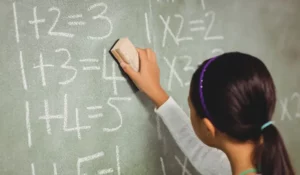
Image credit: National Review
by Dick Hall-Sizemore
I have a dilemma. I can’t decide if I am just like most old farts who think “the way I used to do it” is the right way and the modern way is all screwed up, or if I am just out of touch with the modern way.
Here is the situation. As I have mentioned before, I volunteer in the local elementary school. I meet with a group of fifth-graders twice a week for about 25 minutes to help them with math. Most of the students in the group last fall simply did not know the multiplication tables well. Therefore, I decided to drill them on those tables.
After their mid-year assessment, I got a different group of students. Almost all of these students know the multiplication tables. I realized I need to give them something more challenging. I asked a couple of students to show me how they would go about multiplying a double-digit number and a single digit, such as 14 x 7. One boy did the calculation in his head. The other student wrote it out.
The approach goes like this: multiply 7 times the number in the “ones” column—28. Multiply 7 times the number in the “tens” column—70. Add the two: 98. This is done with a matrix of boxes into which the 28 is placed in one box, and 70 in the other and the two sums are then added. The “old” way of putting 8 in the “ones” column and “carrying” the 2 to the “tens” column is totally foreign to these students.
I understand the theory behind this current approach. It is an attempt to get students to see better what is happening in the calculation. But what if both numbers to be multiplied are double-digit or there is one three-digit and one double-digit number? The number of boxes being used could get awfully messy.
I asked the school coordinator of the “math club” these questions. Her response was that the goal was to get students to the point where they understood the “carrying” concept. Many students get to that stage, but others didn’t. And when I asked about multiplying more than two-digit numbers, she told me that, when they got to that stage in middle school, they were allowed to use calculators. I pressed a little bit more and learned that the SOL tests are constructed so that a calculator pops up on the screen for any word math problem and for any problem involving multiplying more than single digit numbers.
I may be old fashioned, but it seems to me that we are producing generations of students, many of whom do not understand the principles behind the math. They will just know that, when they enter some numbers into a calculator, an answer is produced. They will not understand the mathematical principles used to produce that answer. Instead of being a convenient time-saver, the calculator has become a necessary mysterious black box that produces the answer needed. (And I am not talking about the electronics involved. As far as I am concerned, it is a mysterious black box in that respect!) I wonder if this is part of the reason that American students seem to lag behind students in other developed countries in math. Or am I just being one of those who say, “Back in my day, we had to walk to school through two feet of snow uphill both ways”?


